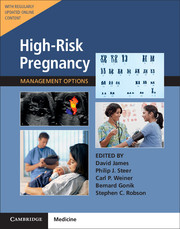Book contents
- Frontmatter
- Contents
- List of Contributors
- Preface
- Section 1 Prepregnancy Problems
- Section 2 Early Prenatal Problems
- Section 3 Late Prenatal – Fetal Problems
- Section 4 Problems Associated with Infection
- Section 5 Late Pregnancy – Maternal Problems
- 30 Substance Misuse in Pregnancy
- 31 Medication in Pregnancy
- 32 Hypertension in Pregnancy
- 33 Cardiac Disease in Pregnancy
- 34 Respiratory Disease in Pregnancy
- 35 Anemia and White Blood Cell Disorders in Pregnancy
- 36 Hematological Malignancies in Pregnancy
- 37 Thrombocytopenia and Bleeding Disorders in Pregnancy
- 38 Disorders of Coagulation in Pregnancy
- 39 Autoimmune Disease in Pregnancy
- 40 Diabetes in Pregnancy
- 41 Thyroid Disease in Pregnancy
- 42 Pituitary and Adrenal Disease in Pregnancy
- 43 Gastrointestinal and Liver Diseases in Pregnancy
- 44 Neurologic Complications in Pregnancy
- 45 Renal Disorders in Pregnancy
- 46 Spine and Joint Disorders in Pregnancy
- 47 Skin Disease in Pregnancy
- 48 Malignant Disease in Pregnancy
- 49 Pregnancy After Transplantation
- 50 Trauma in Pregnancy
- 51 Mental Health Disorders in Pregnancy
- Section 6 Late Prenatal – Obstetric Problems
- Section 7 Postnatal Problems
- Section 8 Normal Values
- Index
40 - Diabetes in Pregnancy
from Section 5 - Late Pregnancy – Maternal Problems
- Frontmatter
- Contents
- List of Contributors
- Preface
- Section 1 Prepregnancy Problems
- Section 2 Early Prenatal Problems
- Section 3 Late Prenatal – Fetal Problems
- Section 4 Problems Associated with Infection
- Section 5 Late Pregnancy – Maternal Problems
- 30 Substance Misuse in Pregnancy
- 31 Medication in Pregnancy
- 32 Hypertension in Pregnancy
- 33 Cardiac Disease in Pregnancy
- 34 Respiratory Disease in Pregnancy
- 35 Anemia and White Blood Cell Disorders in Pregnancy
- 36 Hematological Malignancies in Pregnancy
- 37 Thrombocytopenia and Bleeding Disorders in Pregnancy
- 38 Disorders of Coagulation in Pregnancy
- 39 Autoimmune Disease in Pregnancy
- 40 Diabetes in Pregnancy
- 41 Thyroid Disease in Pregnancy
- 42 Pituitary and Adrenal Disease in Pregnancy
- 43 Gastrointestinal and Liver Diseases in Pregnancy
- 44 Neurologic Complications in Pregnancy
- 45 Renal Disorders in Pregnancy
- 46 Spine and Joint Disorders in Pregnancy
- 47 Skin Disease in Pregnancy
- 48 Malignant Disease in Pregnancy
- 49 Pregnancy After Transplantation
- 50 Trauma in Pregnancy
- 51 Mental Health Disorders in Pregnancy
- Section 6 Late Prenatal – Obstetric Problems
- Section 7 Postnatal Problems
- Section 8 Normal Values
- Index
Summary
Introduction
Diabetes mellitus is a common and important medical complication affecting pregnancy.
The prevalence of diabetes worldwide has risen considerably in recent years. This is in part due to increasing rates of obesity in developed countries, which has reached epidemic proportions. This phenomenon is particularly marked in Asia, leading to a marked increase in the prevalence of type 2 diabetes. The average age for childbearing has also increased, and this too has contributed to an increased incidence of cases of both preexisting diabetes and gestational diabetes mellitus (GDM) in pregnancy.
Previous controversies relating to the diagnosis and management of GDM have been partially resolved because of important advances made in recent years.
Diabetes mellitus is associated with an increased rate of perinatal morbidity and mortality. The St. Vincent Declaration on diabetes care in 1989 cited pregnancy as one of its concerns and aimed to achieve a perinatal outcome rate equivalent to that in the nondiabetic obstetric population. As a generalization, in both preexisting diabetes and GDM, the majority of complications are due to suboptimal maternal glycemic control. Therefore the key issue in the management is to optimize maternal glycemic control. This is multifaceted, and optimal management requires a multidisciplinary approach.
Classification of Diabetes In Pregnancy
There are two forms of diabetes in pregnancy, preexisting (pregestational) diabetes and that which comes on during pregnancy (gestational diabetes).
Pregestational Diabetes Mellitus
Pregestational or preexisting diabetes mellitus includes women who have either type 1 or type 2 diabetes diagnosed before the onset of pregnancy. Owing to an increase in the prevalence of type 2 diabetes, the rate of pregestational diabetes has also risen over the past number of years. In contrast to gestational diabetes mellitus, preexisting diabetes may result in additional complications to the fetus from the first trimester, and pregnancy itself can affect preexisting diabetes-related complications.
Gestational Diabetes Mellitus
Traditionally, gestational diabetes mellitus (GDM) has been defined as any degree of glucose intolerance with onset or first recognition during pregnancy. This definition applies whether or not the condition persists after pregnancy. Thus, it does not exclude the possibility that unrecognized diabetes mellitus may have been present before the onset of pregnancy but detected for the first time in pregnancy.
- Type
- Chapter
- Information
- High-Risk Pregnancy: Management OptionsFive-Year Institutional Subscription with Online Updates, pp. 1160 - 1191Publisher: Cambridge University PressFirst published in: 2017



